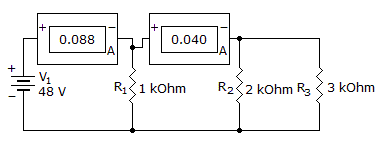Electronics - Parallel Circuits - Discussion
Discussion Forum : Parallel Circuits - General Questions (Q.No. 15)
15.
The current through R1 will be:


Discussion:
17 comments Page 1 of 2.
Sushil said:
8 years ago
Thanks @Seshendra.
Vineeth K said:
9 years ago
48mA is the correct answer.
The total current I eff is V/Reff.
Reff is equivalent resistances of r1 r2 and r3 which is 6/11.
So I=48/6 * 11= 88mA.
88mA is what comes from the source which gets divided into two parts, I1 into resistor r1 and I2 into resistor r2.
Which is given in the diagram through ammeter reading.
V is 48v across all the resistors as the voltage does not get divided in parallel connections.
So, performing I=v/r for each branch r1 r2 and r3 we get a total of 88mA with current through r1 as 48mA, r2 as 24mA and r3 as 16mA.
The total current I eff is V/Reff.
Reff is equivalent resistances of r1 r2 and r3 which is 6/11.
So I=48/6 * 11= 88mA.
88mA is what comes from the source which gets divided into two parts, I1 into resistor r1 and I2 into resistor r2.
Which is given in the diagram through ammeter reading.
V is 48v across all the resistors as the voltage does not get divided in parallel connections.
So, performing I=v/r for each branch r1 r2 and r3 we get a total of 88mA with current through r1 as 48mA, r2 as 24mA and r3 as 16mA.
Armandwish said:
1 decade ago
According to KCL:
I = I1+I2....I1 = I-I2.
I = I1+I2....I1 = I-I2.
Azhagusurya said:
1 decade ago
Consider th first node:
Ii = I1+I2.
Ii = 0.088.
& I2 = 0.040.
So I1 = Ii-I2 = 0.088-0.040.
I1 = 0.048 in mA.
I1 = 48mA.
Ii = I1+I2.
Ii = 0.088.
& I2 = 0.040.
So I1 = Ii-I2 = 0.088-0.040.
I1 = 0.048 in mA.
I1 = 48mA.
PRASANNA KUMAR said:
1 decade ago
Here one simple formula is there,
In parallel circuit I = I1+I2.
IN THE CKT SHOWN ONE CURRENT IS LEAVING(0.088A) AND OTHER ENTERING(0.040A) THEN,
I+0.040 = 0.088.
I = 0.088-0.040.
= 88*10^-3 - 40*10^-3 = 48*10^-3 = 48mA.
In parallel circuit I = I1+I2.
IN THE CKT SHOWN ONE CURRENT IS LEAVING(0.088A) AND OTHER ENTERING(0.040A) THEN,
I+0.040 = 0.088.
I = 0.088-0.040.
= 88*10^-3 - 40*10^-3 = 48*10^-3 = 48mA.
Kamal said:
1 decade ago
@Harish Kumar is wrong because the total resistance calculation is R1.R2.R3/R1R2+R2R3+R3R1.
Harish kumar said:
1 decade ago
We know voltage across parallel circuits are same.
Given that V = 48v.
By ohm's law,
I=V/R.........(1).
Total resistance R1.R2.R3/R1+R2+R3.
= 1.2.3/1+2+3.
= 1 Ohm.
Substitute R value in 1,
I = 48mA.
Given that V = 48v.
By ohm's law,
I=V/R.........(1).
Total resistance R1.R2.R3/R1+R2+R3.
= 1.2.3/1+2+3.
= 1 Ohm.
Substitute R value in 1,
I = 48mA.
Shiva said:
1 decade ago
I = 0.088.
I1 = ?
I2 = 0.040.
Since I = I1+I2 (Kirchhoff current law).
I1 = I-I2 = 0.088 - 0.040 = 0.048 = 48 x 10^-3 = 48mA.
I1 = ?
I2 = 0.040.
Since I = I1+I2 (Kirchhoff current law).
I1 = I-I2 = 0.088 - 0.040 = 0.048 = 48 x 10^-3 = 48mA.
Harika said:
1 decade ago
@according to vasu as req=6/11
I=V/Req =48*(11/6)=88mA
I=V/Req =48*(11/6)=88mA
Dipika said:
1 decade ago
@Niraj is correct answer becoz this three resistsnce are parellel so formula is r1*r2*r3/r1+r2+r3... so total resi r..
& then after ohms law apply...
& then after ohms law apply...
Post your comments here:
Quick links
Quantitative Aptitude
Verbal (English)
Reasoning
Programming
Interview
Placement Papers